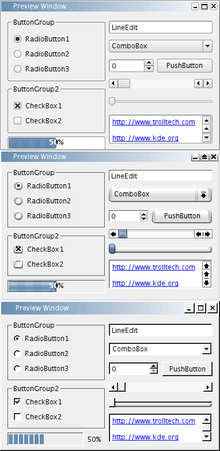Skin (computing)

In computing, a skin (also known as visual styles in Windows XP)[1] is a custom graphical appearance preset package achieved by the use of a graphical user interface (GUI) that can be applied to specific computer software, operating system, and websites to suit the purpose, topic, or tastes of different users. As such, a skin can completely change the look and feel and navigation interface of a piece of application software or operating system.
Software that is capable of having a skin applied is referred to as being skinnable, and the process of writing or applying such a skin is known as skinning. Applying a skin changes a piece of software's look and feel—some skins merely make the program more aesthetically pleasing, but others can rearrange elements of the interface, potentially making the program easier to use.
Common skinnable applications
The most popular skins are for instant messaging clients, media center, and media player software, such as Trillian and Winamp, due to the association with fun that such programs try to encourage.
Standard interface
Some platforms support changing the standard interface, including most using the X Window System. For those that do not, programs can add the functionality, like WindowBlinds for Microsoft Windows and ShapeShifter for macOS.
Model–view–controller
Skinning is typically implemented with a model–view–controller architecture, which allows for a flexible structure in which the interface is independent from and indirectly linked to application functionality, so the GUI can be easily customized. This allows the user to select or design a different skin at will, and also allows for more deep changes in the position and function of the interface elements.
Pros and cons
The benefit of skinning in user interfaces is disputed. While some find it useful or pleasant to be able to change the appearance of software, a changed appearance can complicate technical support and training. A user interface that has been extensively customized by one person may appear completely unfamiliar to another who knows the software under a different appearance. Some usability practitioners feel that this flexibility requires interaction design expertise that users might not have.
Game development
In game development, to skin or reskin a game or assets of a game means applying different graphics to the same underlying model, program or animation. For example, the characters in Serious Sam: The Second Encounter are all reskins of the same model. A game developer can choose to reskin a game while in development, usually for marketing reasons or to better suit their target audience. For example, Super Mario Bros. 2 was a reskin of an existing game to a better known franchise, and Speed Freaks was more serious and darker themed during development, before finally settling on the cartoony look-and-feel.
Websites
Many websites are skinnable, particularly those that provide social capabilities. Some sites provide skins that make primarily cosmetic changes, while some—such as H2G2—offer skins that make major changes to page layout. As with standalone software interfaces, this is facilitated by the underlying technology of the website—XML and XSLT, for instance, facilitate major changes of layout, while CSS can easily produce different visual styles.
See also
References
- ↑ "Visual Styles (Windows)". MSDN. Microsoft. Retrieved 18 March 2013.